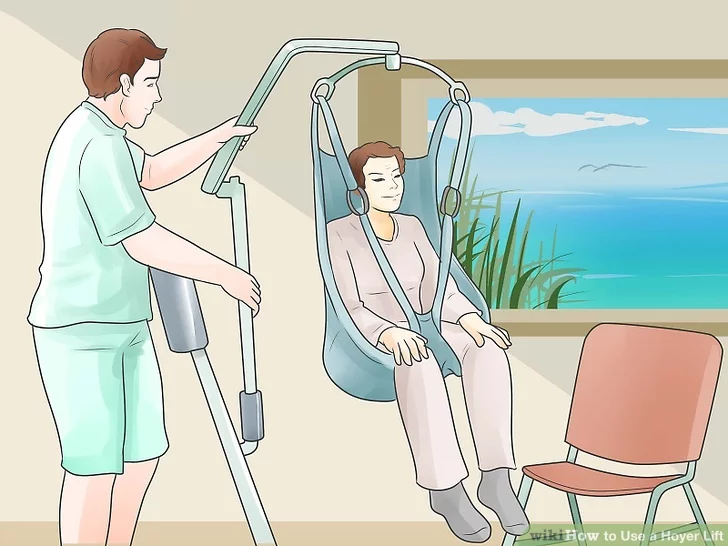
For caregivers, healthcare providers, and family members, using a full body sling for a Hoyer lift can be a game-changer in safely moving individuals with mobility challenges. Full body slings, when paired with Hoyer lifts, make transferring individuals more comfortable and secure, while reducing physical strain on caregivers. This guide will walk you through the steps to safely and effectively use a full body sling with a Hoyer lift, ensuring a smooth experience for both the caregiver and the individual being assisted.
Understanding the Full Body Sling and Hoyer Lift
A full body sling for Hoyer lift is designed to cradle and support an individual’s entire body, distributing weight evenly to avoid discomfort during transfers. Hoyer lifts, whether manual or electric, provide a secure and controlled way to move individuals from one place to another, such as from bed to wheelchair or chair to bathroom. The full body sling connects to the lift’s arms, allowing the device to raise and lower individuals comfortably.
Preparing for a Safe Transfer
Before beginning, ensure that all equipment is in good condition. Check the full body sling for any signs of wear or tears and inspect the Hoyer lift’s parts, especially the battery if it’s electric. Position the lift close to the individual to avoid unnecessary strain or movement.
Steps for preparation:
- Gather all necessary supplies, including the sling, lift, and wheelchair or bed.
- Inform the individual about each step you’ll take to ensure they feel comfortable and secure.
- Lock the wheels on the bed or chair, if applicable, to keep it steady.
Placing the Full Body Sling Under the Individual
Properly positioning the full body sling is essential for comfort and safety. To do this:
- Roll the Individual to One Side: Carefully roll the individual onto their side, then slide the sling under them, with the folded edge close to their back.
- Adjust the Sling: Roll the individual onto their back, spreading the sling out evenly to support the head, torso, and legs.
- Position the Leg Straps: Guide each leg strap under the thighs, crossing them if extra stability is needed.
Attaching the Sling to the Hoyer Lift
Once the sling is properly positioned, it’s time to connect it to the lift.
- Align the Lift: Position the lift directly over the individual, centering the lift’s arms over their chest.
- Attach the Sling Hooks: Secure the sling straps to the designated hooks on the lift. Typically, there are multiple loops on the sling straps, allowing you to adjust for the desired lifting height and comfort.
- Double-Check Connections: Ensure all straps are securely attached and that the individual is well-supported before lifting.
Lifting and Transferring with the Hoyer Lift
With everything securely in place, you’re ready to lift and transfer the individual.
- Begin Lifting: Slowly activate the lift, raising the individual off the bed or chair. Make sure they feel secure, and keep the movement slow to avoid sudden shifts.
- Check Comfort and Positioning: As the lift begins to move, observe the individual’s position, adjusting straps if needed for their comfort.
- Move to the New Position: Carefully guide the lift to the desired location, avoiding sharp turns or abrupt movements.
Lowering and Removing the Sling
Once you’ve safely moved the individual to their new location, it’s time to lower and remove the sling.
- Lower the Lift: Gradually lower the individual onto the new surface, stopping just above the surface to ensure alignment.
- Detach the Sling: Unhook the sling straps from the lift and roll the individual slightly to remove the sling from under them.
- Store the Equipment Safely: Once finished, fold and store the sling and return the lift to its designated area.
Tips for Safe and Comfortable Transfers
To ensure a smooth transfer, keep these tips in mind:
- Communicate Clearly: Explain each step to the individual for their peace of mind.
- Go Slowly: Slow, steady movements reduce the risk of injury and enhance comfort.
- Check Equipment Regularly: Regular inspections help ensure the lift and sling remain in safe working condition.
Conclusion
Using a full body sling for a Hoyer lift requires a few key steps, but once learned, it can make transferring individuals safe and efficient. Following these steps allows for safe, comfortable transfers, protecting both the individual’s dignity and the caregiver’s physical well-being. With the right preparation and careful attention to detail, caregivers can create a positive, stress-free experience that enhances mobility and confidence.